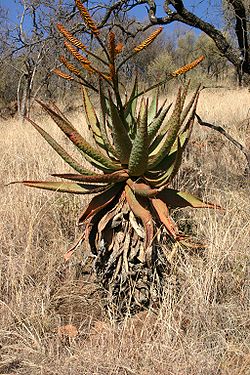Aloe marlothii
| Habit | cacti-succulent
| |
|---|---|---|
| Height: | ⇕ | 12 ft"ft" can not be assigned to a declared number type with value 12. to 15 ft"ft" can not be assigned to a declared number type with value 15. |
| Width: | ⇔ | 7 ft"ft" can not be assigned to a declared number type with value 7. to 10 ft"ft" can not be assigned to a declared number type with value 10. |
| Lifespan: | ⌛ | perennial |
| Bloom: | ❀ | early winter, mid winter, late winter |
| Exposure: | ☼ | sun |
|---|---|---|
| Water: | ◍ | moderate, dry |
| Features: | ✓ | flowers |
| USDA Zones: | 9 to 11 | |
| Flower features: | ❀ | orange, yellow |
|
Aloe > |
Aloe marlothii Berger is a large, single-stemmed Southern African aloe of rocky places and open flat country, occasionally growing to 6m tall. Its distribution ranges from the Klip River Hills in Johannesburg, through eastern Botswana, northwards over the Soutpansbergto Zimbabwe and Malawi and eastwards through Swaziland and Mozambique to the coast. This species grades through intermediate forms into Aloe spectabilis Reynolds of Kwa-Zulu Natal, and the two are now considered synonymous.
Named after Rudolf Marloth, the renowned South African botanist, this species in full flower presents a magnificent spectacle, the trunk densely covered by the withered old leaves, which when green can be up to 1.5m in length and usually densely covered in short spines on the convex lower surfaces and less so on the concave upper surfaces.
The inflorescence is a much-branched panicle with up to 30 or exceptionally 50 racemes . Flower colour ranges from yellow through orange to bright red. Flowering colour is through the winter months, as is the case with most aloes. Aloe marlothii forms natural hybrids with some 30 or more species.
Cultivation
Propagation
Pests and diseases
Varieties
Gallery
Flower raceme Aloe Marlothii, Huntington Desert Garden, California, 2-14-2009
References
External links
- w:Aloe marlothii. Some of the material on this page may be from Wikipedia, under the Creative Commons license.
- Aloe marlothii QR Code (Size 50, 100, 200, 500)




